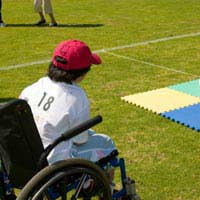Exercise for Kids With Learning Disabilities
By: Suzanne Elvidge BSc (hons), MSc - Updated: 9 Jun 2010
|

Exercise is important for children’s health. Whatever their level of ability or disability, all children should get around an hour of exercise a day. Children with learning disabilities or difficulties should be able to join in with most or all sports activities, provided their individual needs are taken into account.
How Does it Help?
For children with learning disabilities, exercise can improve confidence and social skills, and allow the children to burn off excess energy, which can help with concentration and sleep. Some children with learning disabilities have problem with co-ordination and motor control, and sport and exercise can improve this. Team sports can teach children about teamwork and sharing, and can help to integrate children with learning disabilities into their peer group. Sports and exercise can also help children with learning disabilities deal with frustration and stress. Groups where children with learning disabilities can join in can also give parents or carers a time of respite, as well as an opportunity to meet people in similar situations and provide mutual support.What are the Issues?
There is a huge range of learning difficulties and disabilities, and the issues will vary widely according to the individual disability and the individual child. For example, children with autism spectrum disorders may find it difficult to work as part of a team, and children with attention deficit hyperactivity disorder (ADHD) may struggle to concentrate. Some children will have problems with speech or understanding, and some may not be able to read instructions or recognise numbers. A number of children with learning disabilities may have behavioural disorders as well, which can make it difficult for them to understand about sharing or taking turns, and may cause problems with other children over issues about winning and losing. Some children with learning disabilities may also have physical disabilities, or problems with motor control or co-ordination, and these need to be considered when including them in activities (see ‘Exercise for Kids with Physical Disabilities’). Some learning disabilities are associated with other health issues, such as heart disease in Down’s syndrome, and being fitter can help offset these additional risks.What Sports?
Children with learning disabilities should be able to take part in any sports that other children enjoy, though the rules may need to be adapted according to the learning disabilities or difficulties.How to Help
It is a good idea to keep sports and exercise simple and straightforward for children with learning disabilities. The instructions should be in clear and plain language, and may have to be repeated a number of times. Some children may need written instructions; others may find instructions as cartoons, pictures or photographs more helpful. Having exercises that include lots of repetitions can make them easier to learn. Doing sports and exercise with children with learning disabilities can be very frustrating, but can also be very enjoyable and rewarding.Where to Go
Some local councils, charities and community organisations have created sports groups and coaching especially for children with learning disabilities, or groups that integrate children with learning disabilities in with children without these issues.
Related Articles in the 'Special Concerns' Category...
- Activities for Girls Who Are Reluctant to Exercise.
- Getting to the Olympics: Kids and Competitive Sport
- Exercise for Kids With Physical Disabilities
- How Young Should Children Start Exercising?
- Should Kids Do Competitive Sports?
- Warming Up & Cooling Down
- Special Needs Kids & Exercise
- Preventing Sports Injuries in Kids & Teens
- Safety Gear
- Getting & Staying Motivated to be Fit
- Going from Fat to Fit
- Fitness for the Asthmatic Child
- Exercise & Emotional Well Being
- Exercise for Diabetic Kids
- Exercise for Kids with Juvenile Arthritis
- Exercise & Body Image
- Active Kids & Learning Ability

Re: Compulsory PE in School
My son has just gone into Year 7 and I knew that he would have a hard time in PE. His co ordination isn't great and he has no interest in…
Re: Compulsory PE in School
My daughters in year 13 her school saying PE is compulsory.I have already stated that I feel this isn't true.She attends a special school…
Re: Activities for 3-5 Year Olds
I like the comments exercise is very important for young children
Re: Compulsory PE in School
My son is 8 yrs old and was in football club today. When I came to pick him up they were in shorts and t-shirt outside in heavy rain he…
Re: Compulsory PE in School
I see some comments on here saying that PE is compulsory, however, the Education Act of 2002 prohibits the Secretary of State for…
Re: Compulsory PE in School
I'm in Year 10 and P.E is made a living hell for me, the girls in the class shout at you and put you down swearing at you and telling you…
Re: Compulsory PE in School
There is more to pe than simply sports. It is good for growing brain cells (for real). It is good for social skills (if delivered…
Re: Compulsory PE in School
My son went through he'll at school because of his bullying pe teacher my son has a pigeon chest and shortness of breath and is currently…
Re: Compulsory PE in School
I’m 12 and PE in my opinion is stupid. To me, it’s an entrance ticket for bullying. My school especially needs to understand not everyone…
Re: Active Games for Teens
wow interesting thanks this is my essay!@!!!!!!!!!!!!!!!!